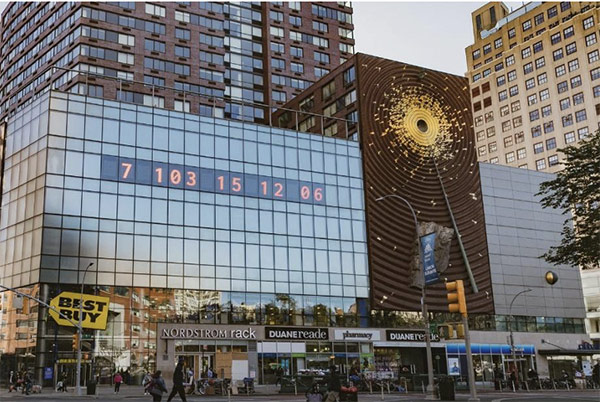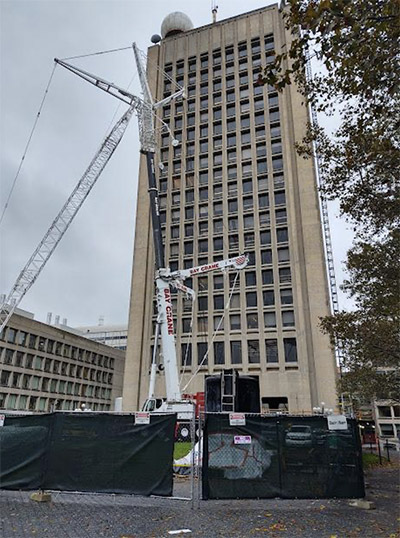
What is the MIT Climate Clock?
A group of students, faculty, alumni, administrators, and staff at the Massachusetts Institute of Technology created the MIT Climate Clock in support of the 26th Conference of the Parties (COP26) proceedings in Glasgow, Scotland, which took place October 31 to November 12, 2021. Thought to be the first university climate clock in the world, when it was originally projected on the south façade of MIT's Green Building on April 22, 2021 (Earth Day), the clock is now projected on the west façade of the Green Building, the tallest building in Cambridge and home to MIT’s Department of Earth, Atmospheric, and Planetary Sciences.
The clock is live through December 6 from 5 pm until 7 am. This new version of the MIT Climate Clock, is visible after dark from various vantage points on the MIT campus, such as from McDermott and Killian Courts, from sections of Memorial Drive, and from the Massachusetts Avenue bridge when crossing from Boston into Cambridge.
The clock presents vital information about the state of our planet — and the pathway to saving it. To see a digital version of messages displayed, see the MIT Climate Clock website.
It all began in spring term 2020, when MIT D-Lab lecturers Susan Murcott and Julie Simpson pitched a class project in their class, D-Lab: Water, Climate Change, and Health. They proposed that a team of students design a monumental public display of rising atmospheric carbon dioxide concentrations, such as the National Oceanographic and Atmospheric Administration (NOAA) carbon dioxide animation, to raise awareness about the need for immediate climate action. At that time, the New York City Climate Clock had yet to be unveiled.
Ironically, the inspiration for the MIT project was the CITGO sign in Kenmore Square — a highly visible advertisement for a petrochemical company and Boston skyline landmark since the 1960s. The MIT team’s idea crystallized around a new landmark for the Cambridge side of the Charles River to address the 21st century’s climate emergency.
Three months later, the New York City Climate Clock went public on September 21, 2020. Jillian James (MIT ’10, MIT ’16, AeroAstro), one of the D-Lab climate sign team members, found out about it and told the team. A Climate Clock! This was exactly in line with what the team was envisioning for MIT and the City of Cambridge!

Generously sharing their work, the artists posted “how to” information on their website. Team member Alejandro Dias, MIT ’21, an Electrical Engineering and Computer Science senior, quickly added their widget to his website.
The MIT Climate Clock’s Message
The MIT Climate Clock features five lines that together highlight the need for climate action:
- Goal: To limit global temperature increase to 1.5o C (2.7o F)” which is the target embraced in the COP25 Paris Agreement of 2015.
- Carbon Dioxide Emissions Budget: 324,002,062,722 tonnes of carbon dioxide, (as of Nov. 17,2021), a very large number from whence one derives the actual time of the climate clock. The “Carbon Dioxide Emissions Budget” represents how much carbon dioxide the world as a whole can release into the atmosphere to maintain at least a 66% chance of avoiding global average temperature increases of 1.5°C (2.7°F).
- Deadline (based on the carbon dioxide budget at current rates): 7 years, 245 days, 7 hours 21 minutes (as of November 17, 2021). The deadline is another way of expressing this budget — it’s the time we have left to take decisive action to limit the global average temperature increase to 1.5°C. Credible current projections suggest we could have less than seven years left.
- Lifeline: The percentage of the world’s energy from renewables is currently at 14.0077837880% (as of November 17, 2021). The “Lifeline” represents the percentage of the world’s energy that is currently provided through renewable sources.
- Message of Hope and Inspiration for Action: “Together we can change!”
Our point is not to spell doom; it’s to inspire action.
Originally Conceived as a Hack!
Originally conceived as a hack, the team chose to abstain from the time-honored MIT custom, because they were seeking to project the Climate Clock long-term. For that, the team needed MIT administration approval and wider MIT community support. When the team petitioned for that approval in early spring 2021, the request was to project the climate clock continuously on the top panel of the Green Building, on the south façade, i.e. the side that faces south to the Charles River. The Office of the Vice President approved a short-term projection of the Climate Clock on the lower panel of the south facade of the Green Building for 10 days in April 2021, in conjunction with Earth Week.

The Delay
The April 2021 Climate Clock projection was occurring during the heart of the pandemic when all classes were virtual and almost no one was on campus. At the time, with MIT discouraging gatherings on campus, it made sense to keep the projection low-profile. However, this meant that few people likely saw it, though it was featured on the MIT D-Lab website and covered by the Boston Globe (MIT students display ‘climate clock’ outside Green Building in Cambridge).
When the April 2021 Climate Clock projection period ended, the team, petitioned the MIT administration for permission to proceed with long-term projection, beginning in summer 2021. By October, we were given permission to resume during the period of COP26, which the team wanted to support.
One significant constraint for a fall term 2021 projection of the MIT Climate Clock was the fact that the Green Building was in the middle of a major renovation, starting in late spring 2021 and lasting for one full year. Given this massive construction project, the MIT administration was extremely accommodating to allow the team to undertake a second projection in the midst of the renovation. The team’s support system has included Maria Zuber and Jim Gomes, MIT Office of the Vice President, Joe Higgins, Vice President of Campus Services and Stewardship, Associate Provost Tim Jamison, Robert van der Hilst, Head of Earth, Atmospheric and Planetary Sciences (EAPS), Richard Wilk, Senior Administrator Chemistry Department, Lachlan Patterson, and Brian Pretti, Department of Facilities, K.C. Lavery and his carpentry staff, Barr and Barr Builders Inc., as well as Captain Martin of MIT Campus Police and many other of his officers who gave the team access to the Building 18 roof.
The team has spent countless hours on the roof, testing, programming, repositioning projections in the dark, and monitoring to ensure that the projection is actually continuing throughout the night, through windstorms, rain, and cold weather, not to mention several shut-downs.

The New Venue
The new Climate Clock is projected from two projectors housed in a specially-built plywood structure atop MIT's Chemistry Building. In contrast, last spring, the equipment was housed in a “doghouse” structure located at ground level. The new structure is physically attached to the parapet wall surrounding the roof of Building 18 and weighted down with sandbags to prevent it from blowing off the roof.
More information
MIT D-Lab class: D-Lab Climate Change and Planetary Health
Contact
Susan Murcott, MIT D-Lab Lecturer

